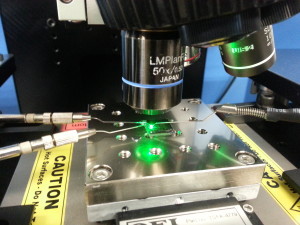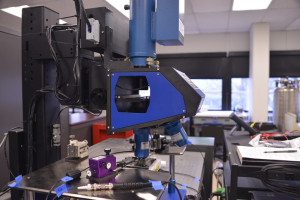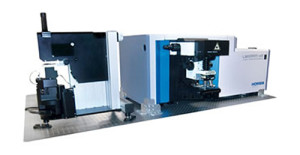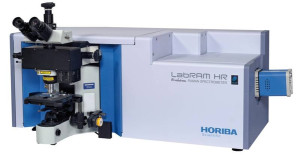HORIBA LabRAM HR Evolution Raman Spectrometer
- Customized/optimized for thermal characterization of microsystems.
- Built-in probe station for in-situ characterization.
- High power (500mW) 532 nm modulated laser source and customized electronics setup allows transient temperature measurement with a temporal resolution of 15 ns.
- The Ultra-fast mapping module and EMCCD detector enables rapid generation of 2-D Raman thermal images.
Educational video: Raman Thermography (2019)
Microsanj NT-210B Thermoreflectance Imaging System
- Generates a sub-micron resolution (~500 nm) 2D temperature image using illumination sources with various wavelengths (340 – 785 nm for our NUV-Vis system, 265 – 340 nm for our DUV system).
- The temperature resolution is ~0.5°C.
- Capable of transient thermal analysis with a temporal resolution of 50 ns.
Educational video: Thermoreflectance Thermal Imaging (2019)
QFI InfraScope-TM Infrared (IR) Microscope System
- 512×512 InSb thermal imaging camera used for detecting mid-wave (3-5 μm) infrared radiation Temperature measurement is possible up to 450°C with a temperature resolution of 1°C.
- Automated pixel-by-pixel emissivity compensation allows quantitative 2-D temperature field assessment.
Educational video: Infrared Thermal Microscopy (2019)
Frequency Domain Thermoreflectance (FDTR) & Steady State Thermoreflectance (SSTR)
- The FDTR technique is an optical pump-probe laser technique where an amplitude-modulated laser beam (the pump, 405 nm wavelength) creates a periodic temperature oscillation at the sample surface, while a second unmodulated beam (the probe, 532 nm wavelength) detects the amplitude and phase of the temperature oscillation which is related to the thermo-physical parameters of the material being measured.
- FDTR allows measurement of the thermal conductivity of thin films and the interfacial thermal boundary resistance (TBR) within heterostructures.
- The SSTR technique is similar to the FDTR but uses a slower modulation frequency to ensure the temperature field of the material system under test reaches steady-state. The increased probing volume, data analysis using a steady-state heat transfer model, and improved measurement sensitivity make SSTR ideal for measurement of the thermal conductivity of bulk substrates and wafers.
Educational video: Frequency Domain Thermoreflectance (2019)
Educational video: Steady State Thermoreflectance (2020)
Time Domain Thermoreflectance (TDTR)
- TDTR is an optical pump-probe method utilizing ultrafast femtosecond laser pulses for measuring the thermophysical properties of materials (in particular, for thin films and heterostructures) by monitoring the temporal diffusion of heat from the surface down through the bulk over a timescale of 100-5000 ps. The system is a two-color configuration with a 514 nm pump beam and a 1028 nm probe beam (76 MHz repetition rate, ~100 fs pulse width). The pump beam is amplitude modulated via an electro-optical modulator (EOM) at 7 MHz to establish a periodic heating event that can be detected via changes in the thermoreflectance of a thin film metal transducer at the surface through lock-in detection (Zurich Instruments UHFLI).
Horiba LabRam HR Evolution Vis-NIR optimized & AIST-NT Scanning Probe
- TERS Raman spectrometer at the Materials Characterization Lab
- Ultra low frequency spectroscopy (> 10cm-1) at 532nm and 633nm wavelengths
- Optimized NIR capabilities (785nm and 1064nm laser) for ‘soft’ material analysis
- Large area fast mapping piezo stage (up to 130 x 85 mm), with fast auto-focus tracking
- Volume mapping
- Simultaneous Raman/AFM measurements
- NSOM and TERS capabilities
- Range of detectors including PMT, EMCCD and LN2 InGaAs detector
Horiba LabRam HR Evolution UV optimized
- UV Raman spectrometers at the Materials Characterization Lab
- Deep (229nm) and near UV (364nm) laser lines for resonance Raman
- Rastering beam spot to avoid laser damage to samples
- High power visible laser lines (100 mW @ 488nm and 420 mW @ 457nm)
- Heating/cooling stage (-196°C to 600°C) with four point probe measurement capabilities for in situ analysis of Raman spectra
- Optimized UV Back Illuminated detector
- Fully achromatic reflective 74x cassegrain objective (range 200nm-1025nm) and Deep UV optimized 40x objective (range 220nm – 450nm)
Updated 4/4/2024
